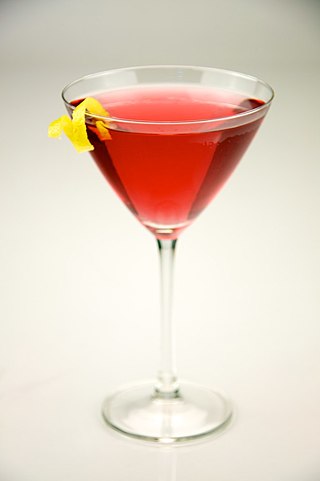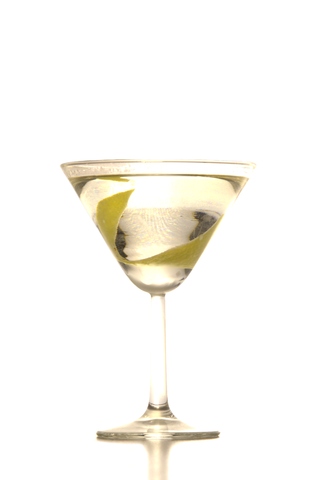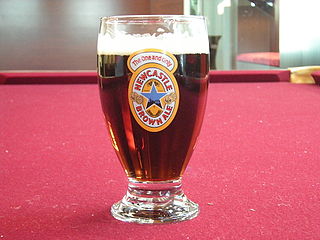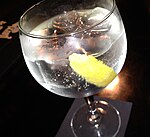
A margarita is a cocktail consisting of tequila, triple sec, and lime juice. Some margarita recipes include simple syrup as well and are often served with salt on the rim of the glass. Margaritas can be served either shaken with ice, without ice, or blended with ice. Most bars serve margaritas in a stepped-diameter variant of a cocktail glass or champagne coupe called a margarita glass. The margarita is one of the world's most popular cocktails and the most popular tequila-based cocktail.

A collins glass is a glass tumbler which typically will contain 300 to 410 millilitres. It is commonly used to serve sparkling cocktails, especially long drinks like the Tom Collins or John Collins. Its cylindrical shape, narrower and taller than a highball glass, keeps the drink carbonated longer by reducing the surface area of the drink.

The martini is a cocktail made with gin and vermouth, and garnished with an olive or a lemon twist. Over the years, the martini has become one of the best-known mixed alcoholic beverages. A popular variation, the vodka martini, uses vodka instead of gin for the cocktail's base spirit.

A cosmopolitan, or, informally, a cosmo, is a cocktail made with vodka, Cointreau, cranberry juice, and freshly squeezed or sweetened lime juice.

A shot glass is a glass originally designed to hold or measure spirits or liquor, which is either imbibed straight from the glass or poured into a cocktail. An alcoholic beverage served in a shot glass and typically consumed quickly, in one gulp, may also be known as a "shooter" or “shot”.

A highball glass is a glass tumbler that can contain 240 to 350 millilitres. It is used to serve highball cocktails and other mixed drinks. An example size is 7 cm (3 in) diameter by 15 cm (6 in) in height. A highball glass is taller than an Old Fashioned glass (lowball), and shorter and wider than a Collins glass.

Stemware is drinkware that stands on stems above a base. It is usually made from glass, but may be made from ceramics or metals. The stem allows the drinker to hold the glass without affecting the temperature of the drink.

Various unique terminology is used in bartending.

A wine glass is a type of glass that is used to drink and taste wine. Most wine glasses are stemware (goblets), i.e., they are composed of three parts: the bowl, stem, and foot.

Beer glassware comprise vessels made of glass, designed or commonly used for serving and drinking beer. Styles of glassware vary in accord with national or regional traditions; legal or customary requirements regarding serving measures and fill lines; such practicalities as breakage avoidance in washing, stacking or storage; commercial promotion by breweries; artistic or cultural expression in folk art or as novelty items or usage in drinking games; or to complement, to enhance, or to otherwise affect a particular type of beer's temperature, appearance and aroma, as in the case of its head. Drinking vessels intended for beer are made from a variety of materials other than glass, including pottery, pewter, and wood.

The old fashioned glass, otherwise known as the rocks glass, whiskey glass, and lowball glass, is a short tumbler used for serving spirits, such as whisky, neat or with ice cubes. It is also normally used to serve certain cocktails, such as the old fashioned. The true old fashioned glass is decorated in the cut glass style, although most modern examples are pressed glass, made using a mold. The design is essentially English, from the late 18th or 19th century. Plain glass versions are lowball glasses.

The Vesper is a cocktail that was originally made of gin, vodka, and Kina Lillet. Since that form of Lillet is no longer produced, modern bartenders need to modify the recipe to mimic the original taste.
A Scorpion Bowl is a communally shared alcoholic tiki drink served in a large ceramic bowl traditionally decorated with wahine or hula-girl island scenes and meant to be drunk through long straws. Bowl shapes and decorations can vary considerably. Starting off as a single-serve drink known as the Scorpion cocktail, its immense popularity as a bowl drink in tiki culture is attributed to Trader Vic.

A champagne glass is stemware designed for champagne and other sparkling wines. The two most common forms are the flute and coupe, both stemmed; holding the glass by the stem prevents warming the drink. Champagne can also be drunk from a normal wine glass, which allows better appreciation of the flavor, at the expense of accentuating the bubbles less.
A carajillo is a cold coffee drink to which a liquor is added. Similar to Irish coffee, it is typical of Spain and several Latin American countries, such as Colombia and Venezuela, where it is usually made with brandy; Cuba, where it is usually made with rum; and in Mexico where mezcal or a coffee liqueur such as Kahlúa or Tía María may be used. Spices such as cinnamon and fruit such as lemon peel are commonly added to more elaborate versions in Spain. Carajillo is usually served in a small glass.

The Glencairn whisky glass is a style of glass intended for drinking whisky, developed and produced by Glencairn Crystal Ltd, in East Kilbride, a town near Glasgow, Scotland since 1981; originally designed by Raymond Davidson, managing director of the company. The shape of the glass is derived from the traditional nosing copitas used in whisky labs around Scotland. The glass design was concluded with the aid of master blenders from five of the largest whisky companies in Scotland. The glass first came into production in 2001. Since then, additional mini-Glencairns and Canadian Glencairns were introduced.

A schooner is a type of glass for serving drinks. In the United Kingdom it is the name for a large sherry glass. In Australia it is the name for a particular glass size, used for any type of beer.

A tumbler is a flat-floored beverage container usually made of plastic, glass or stainless steel.

A Nick & Nora glass is a stemmed glass with an inverted bowl, mainly used to serve straight-up cocktails. The glass is similar to a cocktail glass or martini glass.


















